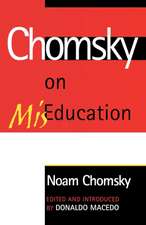Differentiating by Student Interest: Practical Lessons and Strategies
Autor Joni Turvilleen Limba Engleză Hardback – 12 iul 2017
| Toate formatele și edițiile | Preț | Express |
|---|---|---|
| Paperback (1) | 127.98 lei 43-57 zile | |
| Taylor & Francis – 30 apr 2007 | 127.98 lei 43-57 zile | |
| Hardback (1) | 625.03 lei 43-57 zile | |
| Taylor & Francis – 12 iul 2017 | 625.03 lei 43-57 zile |
Preț: 625.03 lei
Preț vechi: 839.00 lei
-26% Nou
Puncte Express: 938
Preț estimativ în valută:
119.60€ • 125.21$ • 98.96£
119.60€ • 125.21$ • 98.96£
Carte tipărită la comandă
Livrare economică 07-21 aprilie
Preluare comenzi: 021 569.72.76
Specificații
ISBN-13: 9781138435636
ISBN-10: 1138435635
Pagini: 192
Dimensiuni: 210 x 280 mm
Greutate: 0.45 kg
Ediția:1
Editura: Taylor & Francis
Colecția Routledge
Locul publicării:Oxford, United Kingdom
ISBN-10: 1138435635
Pagini: 192
Dimensiuni: 210 x 280 mm
Greutate: 0.45 kg
Ediția:1
Editura: Taylor & Francis
Colecția Routledge
Locul publicării:Oxford, United Kingdom
Public țintă
Professional Practice & DevelopmentCuprins
Chapter 1 Differentiating by Interest; Chapter 2 Assessing Interest and Building Classroom Climate; Chapter 3 Lesson Structures that Support Differentiating by Interest; Chapter 4 Lesson Plans; Chapter 5 Creating a Lesson and Adapting Lessons; Chapter 6 Assessment and Other Lingering Issues; Chapter 7 Where to Start?
Descriere
Molecular modeling is becoming an increasingly important part of chemical research and education as computers become faster and programs become easier to use. The results, however, have not become easier to understand. Addressing the need for a "workshop-oriented" book, Molecular Modeling Basics provides the fundamental theory needed to understand not only what molecular modeling programs do, but also the gist of research papers that describe molecular modeling results.Written in a succinct manner using informal language, the book presents concise coverage of key concepts suitable for novices to the field. It begins by examining the potential energy surface (PES), which provides the connection between experimental data and molecular modeling. It explores ways to calculate energy by molecular and quantum mechanics. It describes molecular properties and the condensed phase, and shows how to extract and interpret information from a program output. The author uses hands-on exercises to illustrate concepts and he supplements the text with a blog containing animated tutorials and interactive figures.Drawn from the author‘s own lecture notes from a class he taught for many years at the University of Iowa, this volume introduces topics in such a way that beginners can clearly comprehend molecular modeling results. A perfect supplement to a molecular modeling textbook, the book offers students the "hands-on" practice they need to grasp sophisticated concepts.In addition to his blog, the author maintains a website describing his research and one detailing his seminars.








